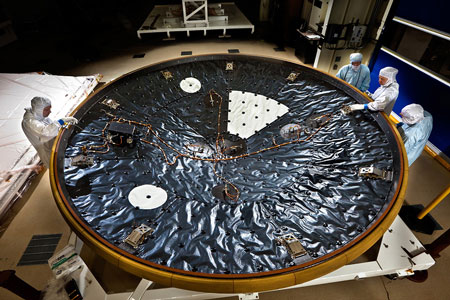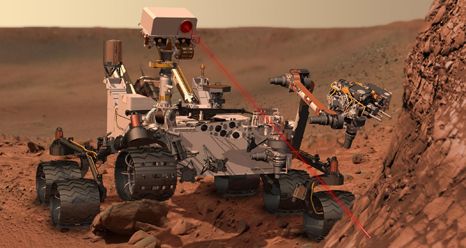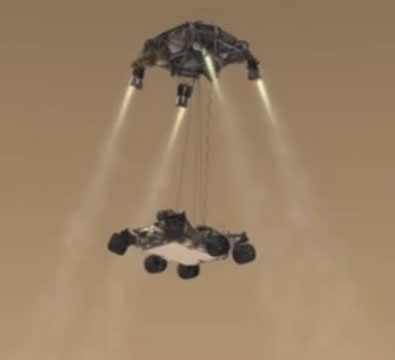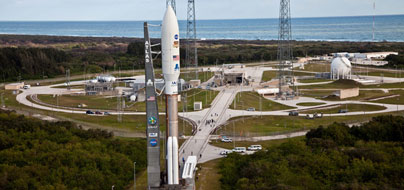Tomorrow morning NASA will launch a Mars Probe, MSL Curiosity, into space for an eight month space journey and then a one year trek across the surface of the planet.
A brief description of the probe:
A new robotic mission to Mars, carrying 10 highly sophisticated instruments to seek the basic chemicals of life in the planet’s ancient rocks, is standing on the launchpad at Cape Canaveral, ready to lift off Saturday morning aboard an Atlas V rocket on a 350 million-mile journey.
The six-wheeled rover named Curiosity is headed for the flanks of a Martian mountain that exists inside a crater where layers of sedimentary rock may hold evidence of what the planet was like a billion or more years ago: warmer, probably; wetter, most probably; and an abode for living organisms – just maybe.
Curiosity’s tools will drill into the mountain’s layered rocks and zap them with a laser so spectrometers can analyze the powdery particles to determine their composition.
Via SFGate
There’s more to the story than lasers and spectral analysis, including a return to nuclear powered robots, this one has a core of plutonium. Not to mention that Curiosity looks like Johnny Five’s bigger, geekier older brother, but that’s not what fascinates me.
It’s the science fiction that does. Two key elements of this mission remind me directly of Star Wars. The first is the Sky Crane that uses rocket thrusters to lower the robot to the surface of Mars.
When the entry phase is complete and the capsule has slowed to Mach 2 and at about 7 km altitude, the heat shield will separate and fall away. The Mars Science Laboratory will then deploy a supersonic parachute, as was done by previous landers such as Viking, Mars Pathfinder and the Mars Exploration Rovers.
Following the parachute braking, at about 1.8 km altitude, still travelling at about 100 m/s, the rover and descent stage drop out of the aeroshell. The descent stage is a platform above the rover with variable thrust mono propellant hydrazine rocket thrusters on arms extending around this platform to slow the descent. Each of the 8 rockets on this stage produce up to 3.1 kN (700 pounds) of thrust and were derived from those used on the Viking landers.
Via Wikipedia
Yeah, thrusters for landing? Pure science fiction..
The other element is entering the planetary atmosphere. NASA’s mission for Curiosity is to:
..improve not only our knowledge of Mars but also the science of hypersonic flight — more than five times the speed of sound — within an out-of-this-world atmosphere. That’s something of great interest to NASA researchers who study flight through all atmospheres so they can help design better air and spacecraft.
Unfortunately, our technology still involves melting away the heat shield, not at all ideal for Han Solo-like adventures. The good news is that top-of-the-line entry involves sublimation which means that the solid is turned into gas (skipping the liquid stage) and that gas creates a wind that blows away the heat.

Perhaps it may be possible one day to skip the melting away of the spacecraft and instead use gas as a shield. Like, injecting the gas directly instead of requiring something to be melted. I mean we’ve always thought shields on a spacecraft would be made of energy but perhaps entering an atmosphere requires a gas shield.
I mean we can drill holes in the heat shield for sensors:
Embedded in the MSL heat shield is a set of sensors designed to record the heat and atmospheric pressure experienced during the spacecraft’s high-speed, extremely hot entry into the Martian atmosphere.
That suite includes two kinds of instruments (with seven sensors of each kind) that are installed in 14 places on MSL’s heat shield, all powered by and feeding data to a black box, the Sensor Support Electronics unit.
One set, MEADS (Mars Entry Atmospheric Data System), required that seven one tenth-inch diameter holes be drilled into the heat shield in a special cross pattern. Those holes are ports for pressure sensors that will measure the atmospheric pressure on the heat shield at the seven MEADS locations during entry and descent through Mars’ atmosphere.
“This isn’t the first time we have drilled tiny holes in a spacecraft,” said Neil Cheatwood, MEDLI principal investigator. “In the 80s we installed pressure sensors in the nose cap of the space shuttle to study hypersonic flow. We have done extensive testing to make sure the MEADS pressure ports can withstand the heat of entry.”
via NASA
First, holes and then gas-shield injections, you read it here first.
If there was one thing I remembered about space travel from Star Wars it was the ability to enter and leave planets, landing with thrusters and using shields for protection. Not like in Star Trek where they had to launch a shuttle for planetary landings. It’s like the democratization of space travel versus the big government model.
I prefer the Han Solo version where I get my own spacecraft and a Chewbacca accomplice. Following this Mars mission makes me feel a little closer to that reality..
Make sure to follow the adventure: MSL Curiosity



Hey not to set off topic but can anyone give me a review of. Philadelphia Car Insurance Reform 1044 Market St. Philadelphia, PA 19107 (215) 618-2175 They are down the block with me. I was wondering if they were a good insurance agency. I need to obtain coverage, it is the law you know, but I have to have a good price price plus I’d prefer friendly service.
Learn how to use mobile social media to boost your business
Shades of grey introduces millions to Lust and trantric secret
Undeniably consider that which you said. Your favourite justification appeared to be at the web the easiest thing to remember of. I say to you, I definitely get annoyed at the same time as other folks consider issues that they plainly don’t know about. You managed to hit the nail upon the highest as neatly as defined out the whole thing with no need side-effects , other folks could take a signal. Will likely be back to get more. Thanks
Mobile Social platform and social networking integration will boost effective marketing for your business